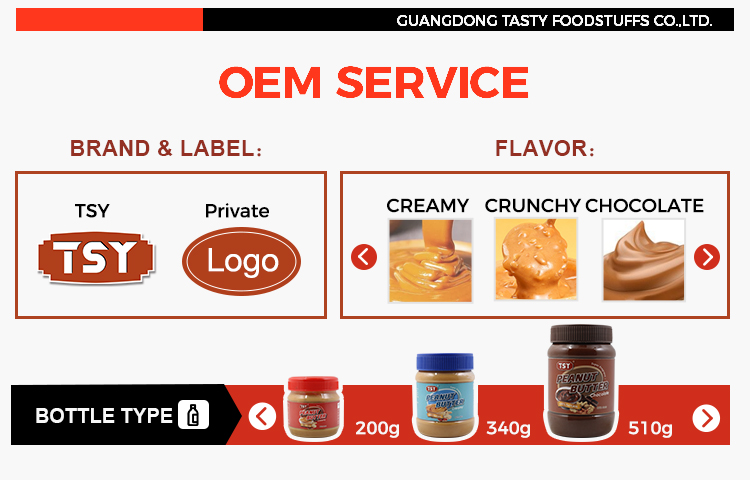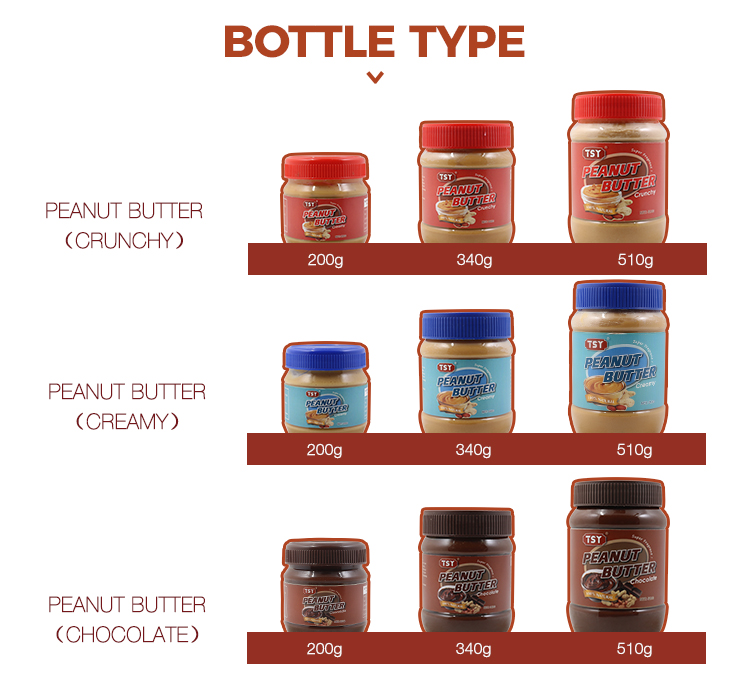TSY or Custom Brands
| Availability: | |
|---|---|
| Quantity: | |








Parameters About TSY Creamy Peanut Butter
| Flavor | With the sweetness of chocolate and the aroma of peanuts |
| Ingredient | Peanuts,Glycerol Monostearate,Salt,Sugar |
| Serving Suggestion | It can be eaten straight or used as a dipping sauce for bread and toast, and as a seasoning for other foods such as hot pot and noodles. |
| Nutrition information typical values per 100g | Energy 2655kJ/635Kcal Protein 22.1g Total fat 50.8g Carbohydrate 23.5g Sodium 560mg |
| Shelf Life | 24 months |
| STORAGE: | Keep at room temperature and moisture proof storage. Please closed After opening use,and store in dry cool place. |
| Certificate | HACCP, BRC, IFS, HALAL, KOSHER, ISO |
What are the differences in the uses of creamy peanut butter and crunchy peanut butter?
The main difference between creamy peanut butter and crunchy peanut butter lies in their texture and how they are commonly used in recipes or as spreads:
1. Creamy Peanut Butter: As the name suggests, creamy peanut butter has a smooth and spreadable texture. It is made by grinding peanuts until they form a smooth paste, with no visible pieces of nuts. Creamy peanut butter is often preferred for making sandwiches, as it spreads easily on bread and provides a consistent texture.
2. Crunchy Peanut Butter: Crunchy peanut butter contains small pieces of crushed peanuts, giving it a chunky texture. Some people enjoy the added texture and nutty crunch that comes from the peanut pieces. It's often used as a topping for toast, pancakes, or waffles, and it can add a delightful texture to various baked goods like cookies and brownies.
Ultimately, the choice between creamy and crunchy peanut butter comes down to personal preference and how you plan to use it in your recipes or as a spread. Both types can be delicious and versatile in different culinary applications.
Parameters About TSY Creamy Peanut Butter
| Flavor | With the sweetness of chocolate and the aroma of peanuts |
| Ingredient | Peanuts,Glycerol Monostearate,Salt,Sugar |
| Serving Suggestion | It can be eaten straight or used as a dipping sauce for bread and toast, and as a seasoning for other foods such as hot pot and noodles. |
| Nutrition information typical values per 100g | Energy 2655kJ/635Kcal Protein 22.1g Total fat 50.8g Carbohydrate 23.5g Sodium 560mg |
| Shelf Life | 24 months |
| STORAGE: | Keep at room temperature and moisture proof storage. Please closed After opening use,and store in dry cool place. |
| Certificate | HACCP, BRC, IFS, HALAL, KOSHER, ISO |
What are the differences in the uses of creamy peanut butter and crunchy peanut butter?
The main difference between creamy peanut butter and crunchy peanut butter lies in their texture and how they are commonly used in recipes or as spreads:
1. Creamy Peanut Butter: As the name suggests, creamy peanut butter has a smooth and spreadable texture. It is made by grinding peanuts until they form a smooth paste, with no visible pieces of nuts. Creamy peanut butter is often preferred for making sandwiches, as it spreads easily on bread and provides a consistent texture.
2. Crunchy Peanut Butter: Crunchy peanut butter contains small pieces of crushed peanuts, giving it a chunky texture. Some people enjoy the added texture and nutty crunch that comes from the peanut pieces. It's often used as a topping for toast, pancakes, or waffles, and it can add a delightful texture to various baked goods like cookies and brownies.
Ultimately, the choice between creamy and crunchy peanut butter comes down to personal preference and how you plan to use it in your recipes or as a spread. Both types can be delicious and versatile in different culinary applications.
We provide professional OEM & ODM services
According to the different tastes and qualities requirements of different customers, we offer Creamy Peanut Butter, Crunchy Peanut Butter, Chocolate Peanut Butter for choice.

This specification of Peanut Butter is cost-effective.

| SPECIFIATION PER CTN | PACKS TYPE | CARTON SIZE (CM) | G.WEIGHT (KGS) /CTN |
| 200g*24tins | Plastic Bottle | 28*21.3*16.5 | 5.80 |
| 340g*24tins | Plastic Bottle | 30.4*23.2*20.7 | 9.40 |
| 510g*24tins | Plastic Bottle | 32.8*24.8*25.7 | 14.20 |
| 1kg*12tins | Plastic Bottle | 38.8*29*17 | 13.00 |
* If you have other needs, please consult us.
We provide professional OEM & ODM services
According to the different tastes and qualities requirements of different customers, we offer Creamy Peanut Butter, Crunchy Peanut Butter, Chocolate Peanut Butter for choice.

This specification of Peanut Butter is cost-effective.

| SPECIFIATION PER CTN | PACKS TYPE | CARTON SIZE (CM) | G.WEIGHT (KGS) /CTN |
| 200g*24tins | Plastic Bottle | 28*21.3*16.5 | 5.80 |
| 340g*24tins | Plastic Bottle | 30.4*23.2*20.7 | 9.40 |
| 510g*24tins | Plastic Bottle | 32.8*24.8*25.7 | 14.20 |
| 1kg*12tins | Plastic Bottle | 38.8*29*17 | 13.00 |
* If you have other needs, please consult us.
Peanut butter is a nutrient-rich food that offers several essential nutrients. Here are some key nutrients found in peanut butter:
1. Protein: Peanut butter is a good source of protein, which is essential for building and repairing tissues in the body.
2. Healthy Fats: It contains monounsaturated and polyunsaturated fats, which are heart-healthy fats that can help reduce bad cholesterol levels.
3. Fiber: Peanut butter provides dietary fiber, which aids in digestion and can help with weight management.
4. Vitamins: It contains various vitamins such as vitamin E, which is an antioxidant, and B vitamins that play roles in energy production.
5. Minerals: Peanut butter contains minerals like magnesium, potassium, and phosphorus, which are important for various bodily functions.
6. Antioxidants: It contains antioxidants like resveratrol, which can help protect the body's cells from damage.
It's worth noting that while peanut butter is nutrient-rich, it is also calorie-dense, so portion control is essential, especially if you are watching your calorie intake. Additionally, some peanut butter brands may contain added sugars or unhealthy fats, so it's a good idea to read the label and opt for natural or organic varieties when possible.
How to use Creamy Peanut Butter for bread:
Using creamy peanut butter for bread is simple and straightforward. Here's a step-by-step guide:
1. Preparation: Make sure your bread slices are ready and any other desired toppings or condiments are within reach.
2. Spread the Peanut Butter: Take a butter knife or a spoon and scoop out the desired amount of creamy peanut butter from the jar. Start spreading it evenly on one slice of bread. Depending on your preference, you can spread it thinly or generously.
3. Optional: Add Sweeteners or Other Spreads: If you like, you can add some sweetness to your peanut butter sandwich by drizzling honey or spreading some fruit preserves or Nutella over the peanut butter.
4. Combine the Slices: Once the peanut butter is evenly spread on one slice, place the other slice of bread on top to make a sandwich.
5. Optional: Cut the Sandwich: If you prefer a smaller serving or need to pack it for later, you can cut the sandwich diagonally or into halves.
And there you have it—a simple and delicious peanut butter sandwich made with creamy peanut butter! Feel free to get creative by adding bananas, apple slices, or even a sprinkle of cinnamon for extra flavor. Enjoy!
Peanut butter is a nutrient-rich food that offers several essential nutrients. Here are some key nutrients found in peanut butter:
1. Protein: Peanut butter is a good source of protein, which is essential for building and repairing tissues in the body.
2. Healthy Fats: It contains monounsaturated and polyunsaturated fats, which are heart-healthy fats that can help reduce bad cholesterol levels.
3. Fiber: Peanut butter provides dietary fiber, which aids in digestion and can help with weight management.
4. Vitamins: It contains various vitamins such as vitamin E, which is an antioxidant, and B vitamins that play roles in energy production.
5. Minerals: Peanut butter contains minerals like magnesium, potassium, and phosphorus, which are important for various bodily functions.
6. Antioxidants: It contains antioxidants like resveratrol, which can help protect the body's cells from damage.
It's worth noting that while peanut butter is nutrient-rich, it is also calorie-dense, so portion control is essential, especially if you are watching your calorie intake. Additionally, some peanut butter brands may contain added sugars or unhealthy fats, so it's a good idea to read the label and opt for natural or organic varieties when possible.
How to use Creamy Peanut Butter for bread:
Using creamy peanut butter for bread is simple and straightforward. Here's a step-by-step guide:
1. Preparation: Make sure your bread slices are ready and any other desired toppings or condiments are within reach.
2. Spread the Peanut Butter: Take a butter knife or a spoon and scoop out the desired amount of creamy peanut butter from the jar. Start spreading it evenly on one slice of bread. Depending on your preference, you can spread it thinly or generously.
3. Optional: Add Sweeteners or Other Spreads: If you like, you can add some sweetness to your peanut butter sandwich by drizzling honey or spreading some fruit preserves or Nutella over the peanut butter.
4. Combine the Slices: Once the peanut butter is evenly spread on one slice, place the other slice of bread on top to make a sandwich.
5. Optional: Cut the Sandwich: If you prefer a smaller serving or need to pack it for later, you can cut the sandwich diagonally or into halves.
And there you have it—a simple and delicious peanut butter sandwich made with creamy peanut butter! Feel free to get creative by adding bananas, apple slices, or even a sprinkle of cinnamon for extra flavor. Enjoy!